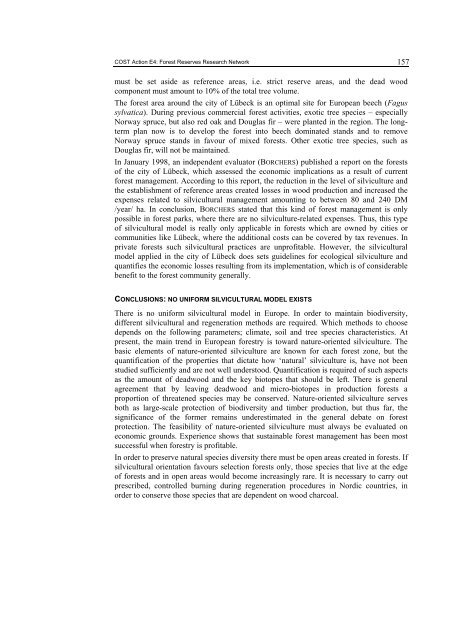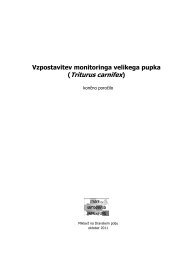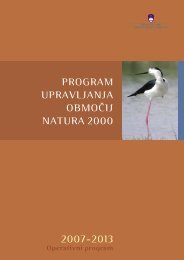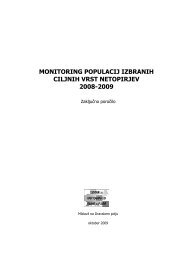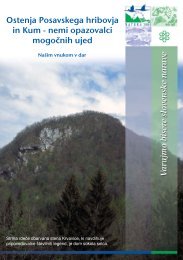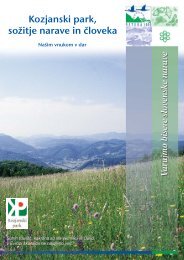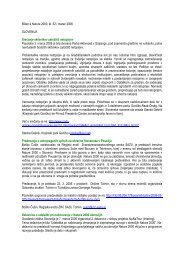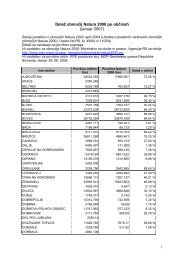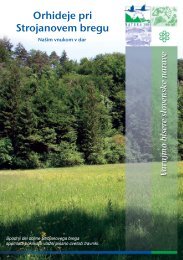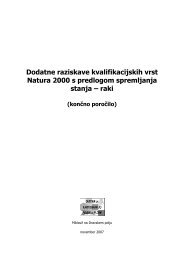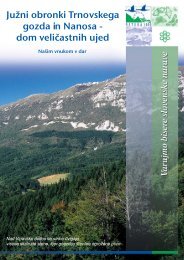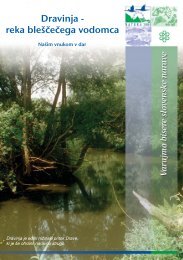VIRGIN FORESTS AND FOREST RESERVES IN ... - Natura 2000
VIRGIN FORESTS AND FOREST RESERVES IN ... - Natura 2000
VIRGIN FORESTS AND FOREST RESERVES IN ... - Natura 2000
Create successful ePaper yourself
Turn your PDF publications into a flip-book with our unique Google optimized e-Paper software.
COST Action E4: Forest Reserves Research Network 157<br />
must be set aside as reference areas, i.e. strict reserve areas, and the dead wood<br />
component must amount to 10% of the total tree volume.<br />
The forest area around the city of Lübeck is an optimal site for European beech (Fagus<br />
sylvatica). During previous commercial forest activities, exotic tree species – especially<br />
Norway spruce, but also red oak and Douglas fir – were planted in the region. The longterm<br />
plan now is to develop the forest into beech dominated stands and to remove<br />
Norway spruce stands in favour of mixed forests. Other exotic tree species, such as<br />
Douglas fir, will not be maintained.<br />
In January 1998, an independent evaluator (BORCHERS) published a report on the forests<br />
of the city of Lübeck, which assessed the economic implications as a result of current<br />
forest management. According to this report, the reduction in the level of silviculture and<br />
the establishment of reference areas created losses in wood production and increased the<br />
expenses related to silvicultural management amounting to between 80 and 240 DM<br />
/year/ ha. In conclusion, BORCHERS stated that this kind of forest management is only<br />
possible in forest parks, where there are no silviculture-related expenses. Thus, this type<br />
of silvicultural model is really only applicable in forests which are owned by cities or<br />
communities like Lübeck, where the additional costs can be covered by tax revenues. In<br />
private forests such silvicultural practices are unprofitable. However, the silvicultural<br />
model applied in the city of Lübeck does sets guidelines for ecological silviculture and<br />
quantifies the economic losses resulting from its implementation, which is of considerable<br />
benefit to the forest community generally.<br />
CONCLUSIONS: NO UNIFORM SILVICULTURAL MODEL EXISTS<br />
There is no uniform silvicultural model in Europe. In order to maintain biodiversity,<br />
different silvicultural and regeneration methods are required. Which methods to choose<br />
depends on the following parameters; climate, soil and tree species characteristics. At<br />
present, the main trend in European forestry is toward nature-oriented silviculture. The<br />
basic elements of nature-oriented silviculture are known for each forest zone, but the<br />
quantification of the properties that dictate how ‘natural’ silviculture is, have not been<br />
studied sufficiently and are not well understood. Quantification is required of such aspects<br />
as the amount of deadwood and the key biotopes that should be left. There is general<br />
agreement that by leaving deadwood and micro-biotopes in production forests a<br />
proportion of threatened species may be conserved. Nature-oriented silviculture serves<br />
both as large-scale protection of biodiversity and timber production, but thus far, the<br />
significance of the former remains underestimated in the general debate on forest<br />
protection. The feasibility of nature-oriented silviculture must always be evaluated on<br />
economic grounds. Experience shows that sustainable forest management has been most<br />
successful when forestry is profitable.<br />
In order to preserve natural species diversity there must be open areas created in forests. If<br />
silvicultural orientation favours selection forests only, those species that live at the edge<br />
of forests and in open areas would become increasingly rare. It is necessary to carry out<br />
prescribed, controlled burning during regeneration procedures in Nordic countries, in<br />
order to conserve those species that are dependent on wood charcoal.


